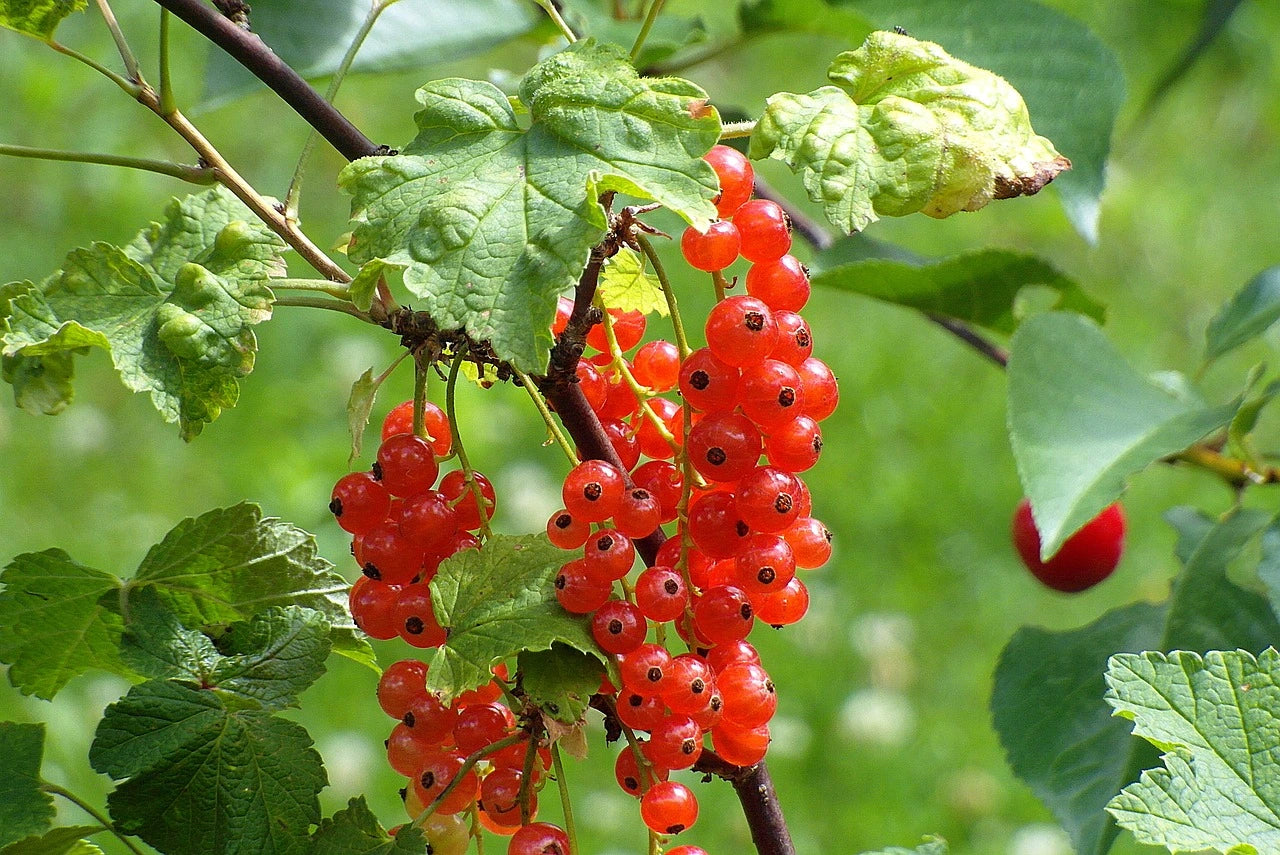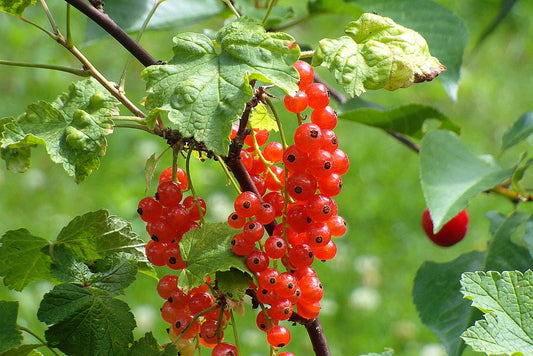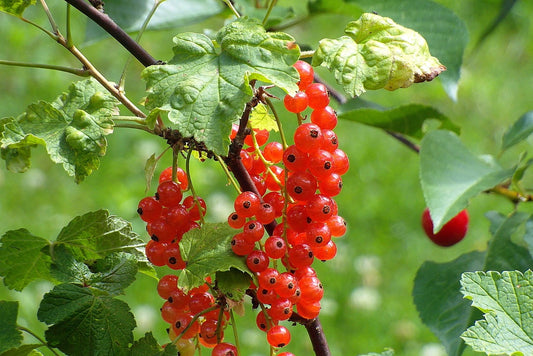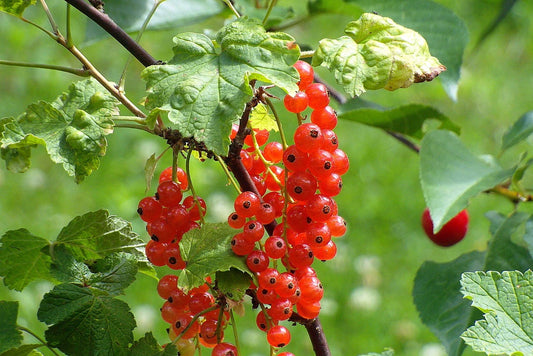-
Delivery from 10 plants within 15 days FR/ EU / CH
Delivery Terms -
Wholesale Supplier of Small Fruit Plants
About Us -
Quality Small Fruit Plants
Technical itinerary for small fruits -
Secure payment
Our Payment Terms
Junifer Organic Vine Currant Plant - Bare Root 2/3 branches
Junifer Organic Vine Currant Plant - Bare Root 2/3 branches
Price € excluding VAT per unit excluding transport. Our prices are based on volume. We offer you the best option based on your needs.
Couldn't load pickup availability
 Buy now and get it delivered when you're ready to plant - Add your desired date to your quote request
Buy now and get it delivered when you're ready to plant - Add your desired date to your quote request
 Delivery from 10 plants within 15 days FR/ EU / CH
Delivery from 10 plants within 15 days FR/ EU / CH
Ce plant de petit fruit est un plant racine-nue
Il reprend aussi bien qu'un plant de petit fruit en godet mais ne se stock pas du fait qu'il n'a pas de motte de terre pour stocker l'eau et les nutriments. A planter rapidement à réception. Les plants de petits fruits racine-nues représentent le meilleur compromis entre coût et qualité
These small fruit plants for professionals are certified organic AB
Buying professional organic berry plants from AB allows you to produce organically. Fruits can be sold organically.
When to Plant / When to Harvest Gooseberry Bushes?
Do you want to grow gooseberries but don't know when to plant them? Do you want to know when you'll harvest them? Consult our Gooseberry Planting and Harvesting Calendar
View full details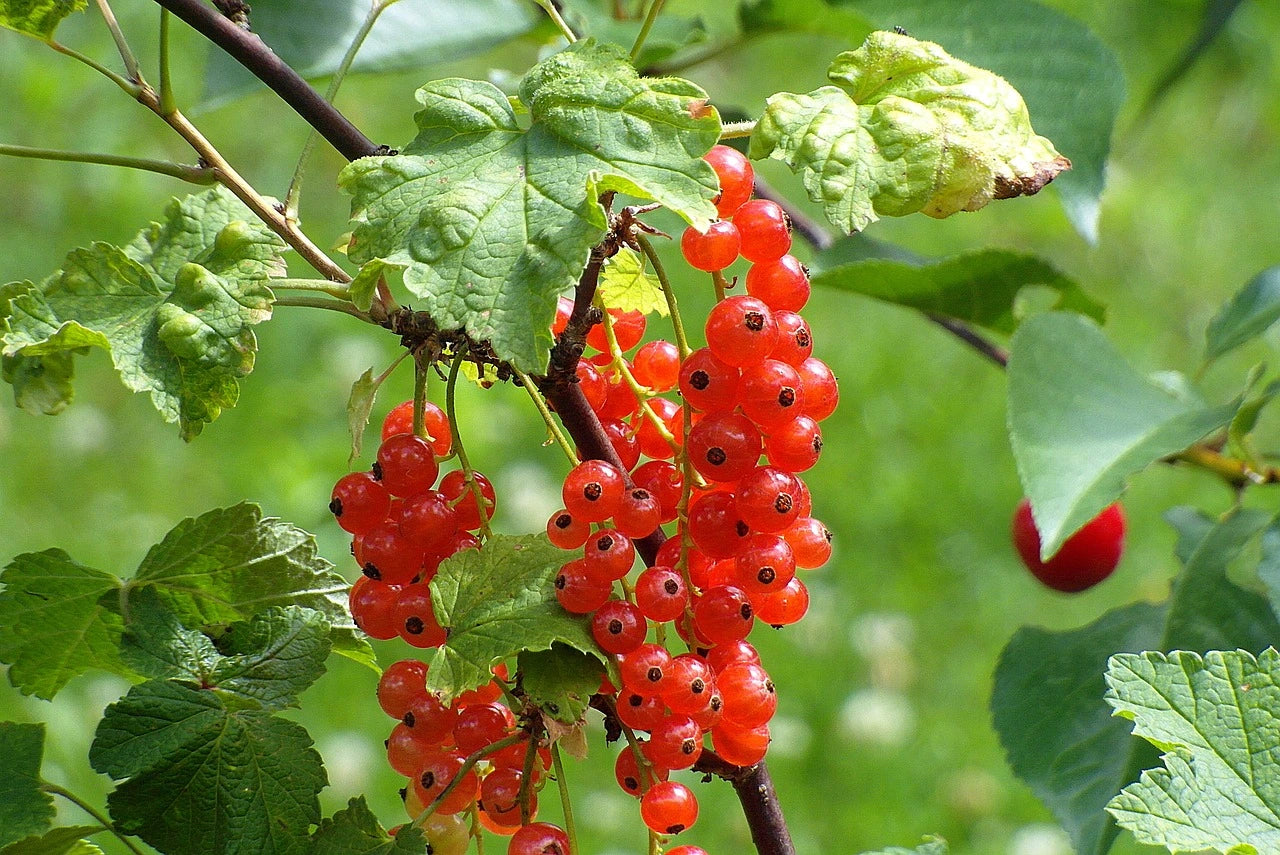
Junifer Gooseberry Bush, quality for professional market gardeners
Junifer Grape Currant Variety Fact Sheet
- Fruit flesh color: Fine, juicy, with a fairly dark juice
- Skin color: Bright red to brilliant red
- Size and shape: Berries of medium to large size, grouped in long, abundant and well-furnished clusters
- Tree Size: Bushy shrub, reaching about 1 to 1.5 meters in height and 1 to 2 meters in width
- Fruit maturity: End of June to July (early variety)
- Fruit Taste: Sweet and tangy, well balanced, very aromatic, slightly acidic. The flesh is juicy and the texture is firm and pleasant in the mouth.
- Earliness of the variety: Early
- Fruiting period End of June to July
- Disease resistance and storage: Good resistance to common diseases (anthracnose, rust). Very good hardiness (down to -15°C or even lower). Good fruit retention on the bunch with little splitting at maturity.
- Variety yield: Very high, reaching 5 to 8 kg per plant per year in conventional cultivation
- Is this variety self-fertile? Yes
- Commercial use: Suitable for fresh consumption and processing (jams, jellies). Particularly effective for professional harvesting, including mechanization.
- Comments: Distinguished by its long and abundant clusters, which makes picking easy. Its berries are well grouped and detach easily when ripe. Well adapted to various growing conditions.
Quick read / the essentials on Junifer grape currant
Created by INRA to meet the expectations of professionals, the Junifer variety embodies the perfect balance between precocity, performance and taste quality. This red currant is known for its very early harvest from the end of June , its ability to produce long and well-stocked bunches , and medium to large fruits (0.7 to 1.1 g). Its bright and shiny red color, its abundant juice (up to 85% of the fresh weight) and its richness in pectin make it a very popular variety, both for direct sale and for artisanal or industrial processing .
The vigorous, bushy plant begins production in its second year, with a professional yield of up to 8 kg per plant . It displays excellent resistance to the main fungal diseases (anthracnose, rust), which allows for simplified phytosanitary management. Its adaptable shape lends itself equally well to fruit hedge management as to mechanized systems. Thanks to its tolerance to varied climates, Junifer adapts equally well to the north and south of France.
For growers looking to buy Junifer gooseberry plants , Bairiverse , a specialist wholesale supplier of gooseberry plants , offers certified plants, ready to be planted in modern, organic or conventional orchards. Each batch is selected to ensure uniformity, rapid recovery and high productivity.
Buying Junifer gooseberry plants means investing in a strategic variety, adapted to the demands of today's market. As a specialist wholesale supplier of gooseberry plants , Bairiverse supports you in your projects, with dedicated technical support and efficient logistics throughout the country.
Origin and varietal development
The 'Junifer' variety is a French creation resulting from the selection work of the National Institute of Agronomic Research (INRA). It was specifically designed to meet the needs of professional cultivation in France, particularly in terms of precocity, productivity, health and adaptation to the varied climatic conditions of the territory.
Description of the fruit
The fruits of 'Junifer' are medium to large in size, with an estimated weight of between 0.7 and 1.1 g per berry. The clusters are long, well-stocked and composed of round berries of a bright to shiny red, very attractive visually. This intense and bright color is a guarantee of maturity and quality, particularly appreciated for fresh sales.
The flesh is juicy and fragrant, with a melting texture and a slightly thick skin that ensures good shelf life after harvest. The flavor is described as balanced, both sweet and tangy, offering a very pleasant freshness. This intense aromatic profile, combined with a high juice content (estimated between 80 and 85% of the fresh weight) and a natural richness in pectin, makes the variety particularly suitable for processing into jams, jellies, syrups or juices.
Maturity period
'Junifer' stands out for its very early maturity. Flowering occurs as early as April-May and the first fruits can be harvested from the end of June. Harvesting then extends until the end of July, depending on the region and climatic conditions. Non-remontant, it produces only one wave of fruit per season, which allows for precise planning of harvest and post-harvest operations.
This precocity makes it one of the earliest varieties on the professional market, offering privileged access to the first outlets of the season, often synonymous with better prices and limited competition.
Plant characteristics
'Junifer' shrubs reach a mature height of 1 to 1.5 meters and can spread up to 2 meters in width. They have a bushy, vigorous habit, sometimes described as "climbing" by some sources, which may warrant training to optimize ventilation, sun exposure, and harvesting. Training as a trained fruit hedge is therefore perfectly feasible.
The plant begins production in the second year after planting, allowing for a rapid return on investment. Productive longevity is generally estimated at between 12 and 15 years, which corresponds to the average for professionally grown gooseberry bushes.
Resistance to diseases and parasites
Junifer exhibits very good resistance to the main fungal diseases of gooseberry, including anthracnose, rust and, to a lesser extent, powdery mildew. This good health significantly reduces the need for phytosanitary treatments, with a reduction estimated at between 30% and 70% depending on cultivation practices. Resistance to pests is also considered satisfactory, although little specifically documented.
Adaptation to soil and climate
The variety adapts to a wide range of soil and climate conditions. It tolerates poor soils, provided they are well-drained, and withstands winter temperatures down to -15°C or even -20°C. However, it is sensitive to active calcareous soils and root asphyxiation, which means that excessively wet or compacted soils should be avoided.
Thanks to its low winter cooling requirements, it is particularly suited to the regions of southern France as well as to areas with an oceanic or temperate climate.
Fertility and pollination
'Junifer' is a self-fertile variety. It does not require the presence of another variety for pollination, which simplifies its management in a single-variety orchard. However, the presence of complementary varieties such as 'Jonkheer van Tets' or 'Gloire des Sablons' can promote cross-pollination and slightly improve fruit size and quantity.
Its honey-producing flowering attracts bees and other pollinators in spring, strengthening the functional biodiversity of the orchard and promoting fertilization in mixed farms or in organic production.
Economic performance
Under optimal growing conditions, 'Junifer' yields between 5 and 8 kg per adult plant, with slightly lower values (3 to 5 kg) in extensive contexts. The recommended planting density (between 1 and 1.5 meters between plants) allows good use of space, particularly in mechanized orchards or fruit hedges.
Its precocity offers a strong strategic advantage: early access to the market, better valuation of volumes, reduction of the harvest schedule. Combined with an excellent processing capacity, this characteristic makes it a highly prized variety for artisanal or industrial processors, as well as for producers involved in short supply chains or organic farming.
Uses and commercial development
'Junifer' is primarily intended for industrial and artisanal processing. Its richness in pectin, juiciness, and sugar/acidity balance make it ideal for jams, jellies, syrups, coulis, and juices. It can also be frozen or used in baking, where its size and intense color are particularly sought after.
It is also suitable for fresh consumption, particularly for direct sales, local markets or organic baskets. Its frank and fragrant flavor, combined with its good stability on the bunch, guarantees an excellent taste experience.
Conclusion
The 'Junifer' red currant combines earliness, yield, disease resistance, and taste quality. Designed for professionals, this French variety represents a reliable and efficient solution for producing red fruits adapted to the demands of today's market. It is equally suited to projects focused on processing as well as those favoring direct sales or short supply chains. In specialized orchards or in diversified agroecosystems, Junifer is a strategic, productive, and sustainable choice.
To summarize: Junifer currant bunches
Junifer is a redcurrant variety developed for growers seeking earliness, robustness, and economic performance. Its bright red, juicy fruits, balanced between sugar and acidity, offer a high yield, both for fresh consumption and processing. Harvesting from the end of June allows for the first markets of the season, which maximizes commercial value and reduces competition.
Its vigorous and adaptable growth, combined with good natural resistance to diseases (anthracnose, rust, powdery mildew), makes it easy to manage in sustainable or organic farming. With a stable production of 5 to 8 kg per plant at maturity, Junifer represents a reliable choice for professionals focused on short supply chains, direct sales or agri-food processing. Self-fertile and melliferous, it also contributes to the biodiversity of orchards.
To buy Junifer gooseberry plants , Bairiverse , a specialist wholesale supplier of gooseberry plants , offers a certified variety offering, adapted to current production requirements. We support producers in the selection, establishment and management of the orchard, with professional support at every stage.
Thanks to our experience as a specialist wholesale supplier of redcurrant plants , you are assured of purchasing high-quality Junifer redcurrant plants , meeting the criteria of performance, precocity and health quality.
Choose Junifer , a sure value on the French market, and trust Bairiverse , your specialist wholesale supplier of redcurrant plants , to buy Junifer redcurrant plants with complete peace of mind.
-
Junifer Organic Red Currant Plant - Rooted Cutting, Height 40–50 cm
Regular price €0,73 EURRegular priceUnit price / per -
Junifer plant bare-rooted Gooseberry plant 1 branch
Regular price €0,75 EURRegular priceUnit price / per -
Junifer Organic Red Currant Plant - Rooted Cutting, Height 50–60 cm
Regular price €0,88 EURRegular priceUnit price / per -
Junifer plant bare-rooted Gooseberry plant 2 branches
Regular price €0,90 EURRegular priceUnit price / per
Additional / Useful information:
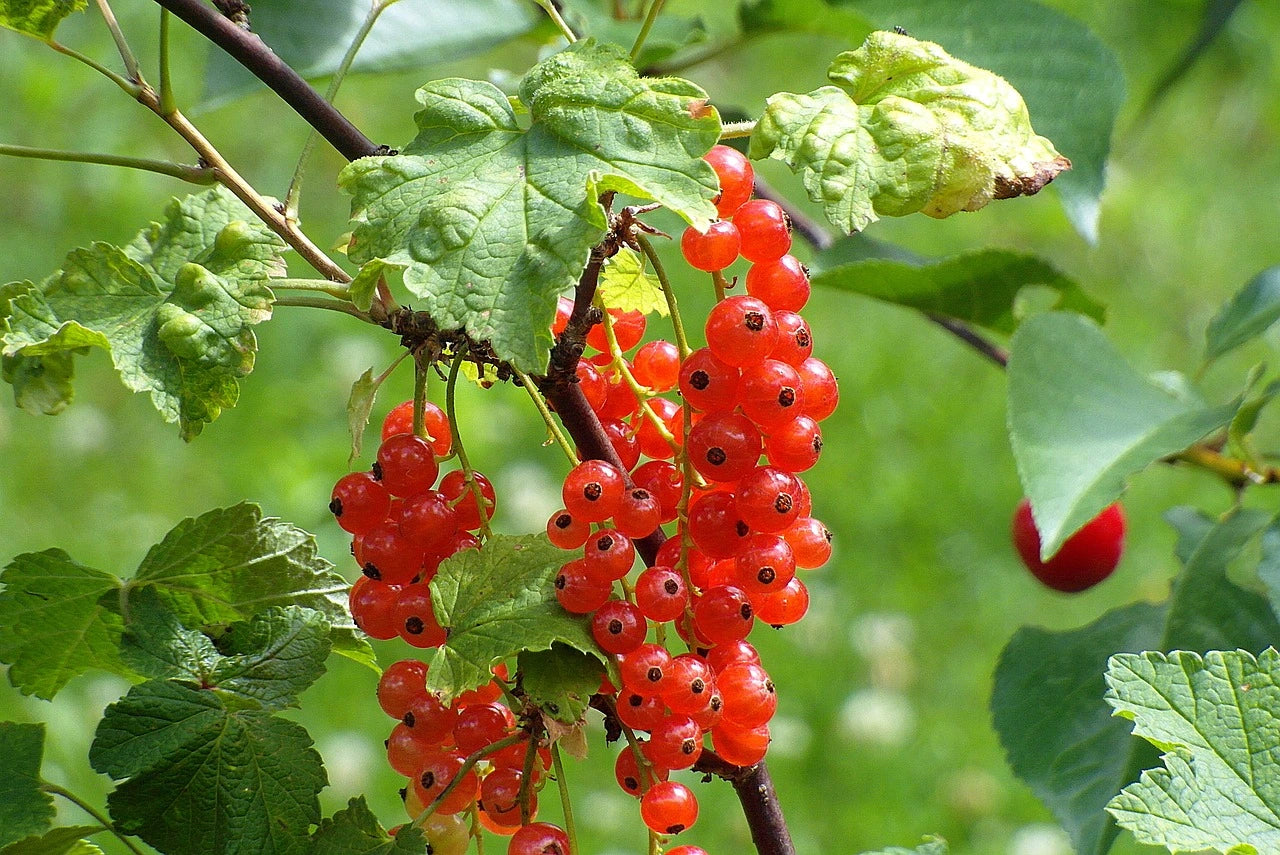
Planting and harvesting calendar for Gooseberries
When to plant gooseberries? When to harvest gooseberries?
Are you looking to start growing gooseberries but don't know when to plant them? Are you also wondering when you'll be harvesting your gooseberries ?
On this page you will find the planting and harvesting periods for each variety of red currant.
| Gooseberry Bushes | Jan | Feb | Mar | Apr | May | Jul | Jul | Aug | Sep | Oct | Nov | Dec | Harvest rate / Production yield | |||||||||||||
|---|---|---|---|---|---|---|---|---|---|---|---|---|---|---|---|---|---|---|---|---|---|---|---|---|---|---|
|
Gooseberry Bush Jonkheer Van Tets |
Planting | 1 year after planting: small harvest 2 years after planting: first yield |
||||||||||||||||||||||||
| Harvest | ||||||||||||||||||||||||||
|
Gooseberry Bush Junifer |
Planting | 1 year after planting: small harvest 2 years after planting: first yield |
||||||||||||||||||||||||
| Harvest | ||||||||||||||||||||||||||
|
Gooseberry Bush Laxton's Perfection |
Planting | 1 year after planting: small harvest 2 years after planting: first yield |
||||||||||||||||||||||||
| Harvest | ||||||||||||||||||||||||||
|
Gooseberry Bush London Market |
Planting | 1 year after planting: small harvest 2 years after planting: first yield |
||||||||||||||||||||||||
| Harvest | ||||||||||||||||||||||||||
|
Gooseberry Bush Rovada |
Planting | 1 year after planting: small harvest 2 years after planting: first yield |
||||||||||||||||||||||||
| Harvest | ||||||||||||||||||||||||||
|
Gooseberry Bush Wilder |
Planting | 1 year after planting: small harvest 2 years after planting: first yield |
||||||||||||||||||||||||
| Harvest | ||||||||||||||||||||||||||
|
Gooseberry Bush Mulka |
Planting | 1 year after planting: small harvest 2 years after planting: first yield |
||||||||||||||||||||||||
| Harvest | ||||||||||||||||||||||||||
|
Gooseberry Bush Glory of the Sablons |
Planting | 1 year after planting: small harvest 2 years after planting: first yield |
||||||||||||||||||||||||
| Harvest | ||||||||||||||||||||||||||
|
Gooseberry Bush Champagne Rose |
Planting | 1 year after planting: small harvest 2 years after planting: first yield |
||||||||||||||||||||||||
| Harvest | ||||||||||||||||||||||||||
|
Gooseberry Bush Bar Le Duc |
Planting | 1 year after planting: small harvest 2 years after planting: first yield |
||||||||||||||||||||||||
| Harvest | ||||||||||||||||||||||||||
|
Gooseberry Bush White Cherry |
Planting | 1 year after planting: small harvest 2 years after planting: first yield |
||||||||||||||||||||||||
| Harvest | ||||||||||||||||||||||||||
|
Gooseberry Bush Red Lake |
Planting | 1 year after planting: small harvest 2 years after planting: first yield |
||||||||||||||||||||||||
| Harvest | ||||||||||||||||||||||||||
|
Gooseberry Bush Red Start |
Planting | 1 year after planting: small harvest 2 years after planting: first yield |
||||||||||||||||||||||||
| Harvest | ||||||||||||||||||||||||||
|
Gooseberry Bush Rolan |
Planting | 1 year after planting: small harvest 2 years after planting: first yield |
||||||||||||||||||||||||
| Harvest | ||||||||||||||||||||||||||
|
Gooseberry Bush Rondom |
Planting | 1 year after planting: small harvest 2 years after planting: first yield |
||||||||||||||||||||||||
| Harvest | ||||||||||||||||||||||||||
| Rosetta Gooseberry | Planting | 1 year after planting: small harvest 2 years after planting: first yield |
||||||||||||||||||||||||
| Harvest | ||||||||||||||||||||||||||
|
Gooseberry Bush Rotet |
Planting | 1 year after planting: small harvest 2 years after planting: first yield |
||||||||||||||||||||||||
| Harvest | ||||||||||||||||||||||||||
|
Gooseberry Bush Blanka |
Planting | 1 year after planting: small harvest 2 years after planting: first yield |
||||||||||||||||||||||||
| Harvest | ||||||||||||||||||||||||||
|
Gooseberry Bush Primus |
Planting | 1 year after planting: small harvest 2 years after planting: first yield |
||||||||||||||||||||||||
| Harvest | ||||||||||||||||||||||||||
| Werdavia Grape Gooseberry Bush | Planting | 1 year after planting: small harvest 2 years after planting: first yield |
||||||||||||||||||||||||
| Harvest | ||||||||||||||||||||||||||
|
Gooseberry Bush White Dutchwoman |
Planting | 1 year after planting: small harvest 2 years after planting: first yield |
||||||||||||||||||||||||
| Harvest | ||||||||||||||||||||||||||
|
Gooseberry Bush White Versailles |
Planting | 1 year after planting: small harvest 2 years after planting: first yield |
||||||||||||||||||||||||
| Harvest | ||||||||||||||||||||||||||
|
Gooseberry Bush Zitavia |
Planting | 1 year after planting: small harvest 2 years after planting: first yield |
||||||||||||||||||||||||
| Harvest | ||||||||||||||||||||||||||
Jonkheer Van Tets Grape Currant: Planting and Harvesting Period
The Jonkheer Van Tets Gooseberry bush is planted from September to November or from February to May. The fruiting/harvesting period for the Jonkheer Van Tets Gooseberry bush is from June to July. The Jonkheer Van Tets Gooseberry bush is a non-remontant variety.
Junifer Grape Currant: Planting and Harvesting Period
Junifer Gooseberry is planted from September to November or from February to May. The fruiting/harvesting period for Junifer Gooseberry is from late June to late July. Junifer Gooseberry is a non-remontant variety.
Laxton's Perfection Gooseberry: Planting and Harvesting Time
Laxton's Perfection Gooseberry is planted from September to November or from February to May. The fruiting/harvesting period for Laxton's Perfection Gooseberry is in July. Laxton's Perfection Gooseberry is a non-everbearing variety.
Gooseberry Bush London Market: Planting and Harvesting Period
The London Market Gooseberry is planted from September to November or from February to May. The fruiting/harvesting period for the London Market Gooseberry is from mid-July to mid-August. The London Market Gooseberry is a non-everbearing variety.
Rovada Gooseberry Bush: Planting and Harvesting Period
The Rovada Gooseberry bush is planted from September to November or from February to May. The fruiting/harvesting period for the Rovada Gooseberry bush is from late July to late August. The Rovada Gooseberry bush is a non-remontant variety.
Wilder Gooseberry Bush: Planting and Harvesting Period
Wilder Gooseberry is planted from September to November or from February to May. The fruiting/harvesting period for Wilder Gooseberry is in July. Wilder Gooseberry is a non-remontant variety.
Mulka Gooseberry Bush: Planting and Harvesting Period
Mulka Gooseberry is planted from September to November or from February to May. The fruiting/harvesting period for Mulka Gooseberry is in August. Mulka Gooseberry is a non-remontant variety.
Gloire des Sablons Gooseberry Bush: Planting and Harvesting Period
The Gloire des Sablons Gooseberry bush is planted from September to November or from February to May. The fruiting/harvesting period for the Gloire des Sablons Gooseberry bush is from mid-July to the end of August. The Gloire des Sablons Gooseberry bush is a non-remontant variety.
Champagne Rose Gooseberry Bush: Planting and Harvesting Period
The Champagne Pink Gooseberry bush is planted from September to November or from February to May. The fruiting/harvesting period for the Champagne Pink Gooseberry bush is from mid-July to mid-August. The Champagne Pink Gooseberry bush is a non-remontant variety.
Bar Le Duc Grape Gooseberry Bush: Planting and Harvesting Period
The Bar Le Duc Gooseberry bush is planted from September to November or from February to May. The fruiting/harvesting period for the Bar Le Duc Gooseberry bush is from late July to late August. The Bar Le Duc Gooseberry bush is a non-remontant variety.
White Cherry Gooseberry Bush: Planting and Harvesting Period
The White Cherry Gooseberry bush is planted from September to November or from February to May. The fruiting/harvesting period for the White Cherry Gooseberry bush is from late July to late August. The White Cherry Gooseberry bush is a non-remontant variety.
Red Lake Gooseberry Bush: Planting and Harvesting Time
Red Lake Gooseberry is planted from September to November or from February to May. The fruiting/harvesting period for Red Lake Gooseberry is from mid-July to the end of August. Red Lake Gooseberry is a non-everbearing variety.
Red Start Gooseberry: Planting and Harvesting Period
Red Start Gooseberry is planted from September to November or from February to May. The fruiting/harvesting period for Red Start Gooseberry is from mid-August to the end of August. Red Start Gooseberry is a non-remontant variety.
Rolan Gooseberry Bush: Planting and Harvesting Period
The Rolan Gooseberry bush is planted from September to November or from February to May. The fruiting/harvesting period for the Rolan Gooseberry bush is from July to August. The Rolan Gooseberry bush is a non-remontant variety.
Rondom Gooseberry Bush: Planting and Harvesting Period
The Rondom Gooseberry bush is planted from September to November or from February to May. The fruiting/harvesting period for the Rondom Gooseberry bush is from mid-July to the end of August. The Rondom Gooseberry bush is a non-remontant variety.
Rosetta Gooseberry Bush: Planting and Harvesting Period
Rosetta Gooseberry is planted from September to November or from February to May. The fruiting/harvesting period for Rosetta Gooseberry is from mid-July to the end of August. Rosetta Gooseberry is a non-remontant variety.
Rotet Grape Gooseberry Bush: Planting and Harvesting Period
The Rotet Gooseberry bush is planted from September to November or from February to May. The fruiting/harvesting period for the Rotet Gooseberry bush is from mid-August to the end of August. The Rotet Gooseberry bush is a non-remontant variety.
Blanka Gooseberry Bush: Planting and Harvesting Period
Blanka Gooseberry is planted from September to November or from February to May. The fruiting/harvesting period for Blanka Gooseberry is from July to August. Blanka Gooseberry is a non-remontant variety.
Primus Gooseberry Bush: Planting and Harvesting Period
Primus Gooseberry is planted from September to November or from February to May. The fruiting/harvesting period for Primus Gooseberry is from mid-June to mid-July. Primus Gooseberry is a non-remontant variety.
Werdavia Gooseberry Bush: Planting and Harvesting Period
The Werdavia Gooseberry bush is planted from September to November or from February to May. The fruiting/harvesting period for the Werdavia Gooseberry bush is from July to August. The Werdavia Gooseberry bush is a non-remontant variety.
White Dutch Gooseberry: Planting and Harvesting Period
The White Dutch Gooseberry is planted from September to November or from February to May. The fruiting/harvesting period for the White Dutch Gooseberry is from mid-July to the end of August. The White Dutch Gooseberry is a non-remontant variety.
White Versaillaise Gooseberry Bush: Planting and Harvesting Period
The White Versaillaise Gooseberry is planted from September to November or from February to May. The fruiting/harvesting period for the White Versaillaise Gooseberry is from July to August. The White Versaillaise Gooseberry is a non-remontant variety.
Zitavia Gooseberry Bush: Planting and Harvesting Period
Zitavia Gooseberry is planted from September to November or from February to May. The fruiting/harvesting period for Zitavia Gooseberry is from July to August. Zitavia Gooseberry is a non-remontant variety.
Which Variety of Gooseberries Should You Choose? Characteristics and Uses of Gooseberries
How to choose your variety of Gooseberry bushes?
You would like to plant Gooseberry bushes on your plot but you don't know which variety of Gooseberry bushes to grow Which grapes to choose? This guide to currant varieties Grappes lists the main varieties along with their characteristics and uses. For farm sales, supermarket sales, or processing? There's something for everyone.
If you are looking for another variety of Gooseberry Grapes do not hesitate to contact us: contact us
Our ranges of Gooseberry bushes Clusters :
Organic Gooseberry Range for Professionals
Conventional Gooseberry Bush Range for Professionals
Gooseberry Variety Guides Clusters :
| Variety | Fruit Color | Remontante | Precocity | Productivity | Fruit Size / Shape | Disease Resistance / Hardiness | Fruiting Period | Taste | Self-fertile |
|---|---|---|---|---|---|---|---|---|---|
| Jonkheer Van Tets | Bright Red | Non-Rising | Early | Very productive variety | Medium to large fruit cluster | Vigorous variety with good disease resistance, adapts to poor soil and is very cold resistant. | June-July | Juicy berries with a sweet taste. Suitable for fresh or for making jam, for example. Its juice is quite dark. The skin is a little thick. | Yes |
| Junifer | Bright red | Non-Rising | Early | Very productive variety | Long bunches | Little need for cooling, suitable for the south of France | End of June to End of July | Perfect for processing because it is rich in pectin, which makes it easier to make jam. | Yes |
| Laxton's Perfection | Dark red | Non-Rising | Season | Very productive variety | Large bunches. Large fruit. | recommended in northern or continental regions with cold winters, good hardiness and disease resistance but average vigor | July | Pleasantly fragrant, sweet and tangy with firm fruit | Yes |
| London Market | Light red | Non-Rising | Mid-Season | Excellent yield. Can reach around 7 kg per plant in optimal conditions. | Long, compact clusters. Large fruit. Round berries. | Very hardy and vigorous variety. Resists down to -15°C. Good disease resistance. Do not plant on plains south of the Loire. | Mid-July to Mid-August | Juicy and tangy pulp, rich in pectin, therefore ideal for processing | Yes |
| Rovada | Red | Non-Rising | Late | Very large production, easy to pick, reliable production, picking can be delayed because the fruit stays on the plant well | Long bunches | Resists fungal and leaf diseases. Attracts bees and butterflies. | End of July to End of August | Very tasty. Fragrant and slightly tangy. Suitable for fresh or processing. | |
| Wilder | Red | Non-Rising | Season | Very productive | Long bunches, medium size | Good disease resistance | July | Very tasty fruit, good sugar-acid balance | Yes |
| Mulka | Dark red | Non-Rising | Late | Very productive | Small berries, long clusters | Moderately vigorous but possible in mountain cultivation because it is very late. Needs soil enriched with organic matter. | August | Very sweet and aromatic fruit | Yes |
| Glory of the Sablons | Light Pink | Non-Rising | Late | Productive variety | Long bunches, medium size | Vigorous variety. Not suitable for calcareous soils. Resists diseases well and down to -20°C. Not very susceptible to diseases except pest attacks. | Mid-July to End of August | Sweet and slightly acidic flavor | Yes |
| Champagne Rose | Pink | Non-Rising | Mid-Season | Good production | Numerous medium-sized clusters | Adapts to all types of soil. Vigorous variety. | Mid-July to Mid-August | Sweet and mild flavor | |
| Bar Le Duc | White | Non-Rising | Late | Average productivity | Medium-sized, narrow cluster | Hardy and moderately vigorous variety | End of July to End of August | Contains very few seeds. Can be used fresh or in processing: sorbet, jam, pastry juice, quite acidic and fragrant. | Yes |
| White Cherry | White-Pink | Non-Rising | Late | Good production. Easy to pick. | Long clusters. Medium-sized fruit. | Good disease resistance but moderately vigorous | End of July to End of August | Firm fruit. Tangy and fragrant taste. Juicy. Very good fresh | Yes |
| Red Lake | Red | Non-Rising | Late | Very productive, easy to pick | Long bunches | Highly resistant to diseases such as powdery mildew and anthracnose | Mid-July to End of August | Good sugar-acid ratio. Very fragrant. Slightly tart. | Yes |
| Red Start | Red | Non-Rising | Very late (after Red Lake) | Good performance | Long clusters. Medium-sized fruit. | Mid-August to late August | Good acidic flavor. Very good for making into jellies. | Yes | |
| Rolan | Bright red | Non-Rising | Season | Very productive variety. Easy to pick. | Long clusters. Medium-sized fruit. | Very disease-resistant variety. High cold requirements. Suitable for harsh winters. | July to August | Very tasty. Slightly tangy. Medium aromatic. Suitable for all uses (fresh or processed) | Yes |
| Rondom | Pale red | Non-Rising | Late | Very productive. Easy to pick. Known for its yield. | Firm fruit. Large, regular-sized berries. Firm | Hardy variety. Good tree retention. High light requirements. Strong immune system. | Mid-July to End of August | Exceptional flavor. Perfect for making into a pie. | Yes |
| Rosetta | Bright red color. Perfect for decoration because of its beautiful color. | Non-Rising | Late | Very productive | Large fruit | The fruit may burst in hot weather after heavy rain | Mid-July to End of August | Perfect for making red fruit coulis or jam. Acidic taste | Yes |
| Rotet | Bright red | Non-Rising | Very late | Reliable variety. Good productivity every year. | Medium to large fruit | Hardier than average variety. Resists splitting after rain. | Mid-August to late August | Very sour taste. Perfect for processing and decoration. | Yes |
| Blanka | Yellow-whitish | Non-Rising | Season | Good productivity (between 6 and 11KG per shrub) | Medium-sized fruit | Very disease resistant but susceptible to powdery mildew | July to August | Juicy and fresh with large seeds | Yes |
| Primus | Translucent white | Non-Rising | Season | High-yielding variety | Medium to large fruit | Retains its quality for a long time on the tree, then takes on a pinkish color. Resistant to diseases but slightly susceptible to mildew | Mid-June to Mid-July | Acidic and juicy. Suitable for fresh or juicy consumption. One of the sweetest white currant varieties. Variety very rich in Vitamin C. | Yes |
| Werdavia | Light Yellow | Non-Rising | Season | Variety with excellent yield potential | Very large bunches | Hardy variety. Very disease resistant. Will withstand cold down to -22°C | July to August | Very tasty and rich in vitamin C. Sweet, tangy and fragrant taste | Yes |
| White Dutchwoman | White tinged with pink | Non-Rising | Late | Variety that offers a good yield | Large berries, long bunches | Reliable variety. Disease resistant. | Mid-July to End of August | Sweet and fragrant flavor. Ideal for fresh consumption. | Yes |
| White Versailles | Translucent white with amber reflection | Non-Rising | Season | Productive variety, easy to harvest | Numerous short bunches, medium-sized fruit | Good disease resistance. Frost resistant down to -15°C. Adapts to all soil types except those with excessive chalkiness. | July to August | Juicy and sweet pulp | Yes |
| Zitavia | Yellow-whitish berries | Non-Rising | Season | High-yielding variety. Up to 7 kg per year/bush | Long bunches, large berries | Variety with fruits that remain on the tree for a long time. Resistant to rain and various diseases. Adapts to all soils. | July to August | Very sweet compared to red berries, juicy and very tasty. Perfect fresh or processed. | Yes |
Gooseberry Market in France in 2025
The French currant market offers promising opportunities for market gardeners, with growing demand for local and organic products, supported by favorable trends in the agri-food, cosmetics, and dietary supplement sectors. However, this crop also presents challenges, including international competition, climatic hazards, and high production costs, requiring tailored strategies to maximize profitability and meet market expectations.
Currants: Presentation and Uses
The gooseberry is a bushy shrub that can reach 1 to 2 meters in height, native to the temperate regions of Europe and Asia . Its fruits, currants, are small red, pink or white berries which grow in clusters of 7 to 20 grains . They have a tangy, sweet flavor, with a shiny, translucent skin .
In France, currants are mainly used in the food industry for the production of jams, jellies and syrups, thanks to their richness in pectin . They are also very popular in baking and dessert decoration . The hospitality sector remains an important outlet, but retail sales are becoming increasingly important, especially in winter . Gooseberries are also made into fruit puree or frozen for use throughout the year .
- Main varieties cultivated in France:
- Jonkher von tets (bright red)
- Glory of the Sands (pale pink)
- White Versailles
Evolution of the Gooseberry Market
The French currant market has seen mixed trends over the past three years. In conventional agriculture, cultivated areas have remained relatively stable, with a slight decrease of 2% between 2022 and 2024 . Production volumes fluctuated depending on weather conditions, with 2023 being a particularly difficult year due to late frost episodes.
The organic market is seeing more positive momentum. The area cultivated with organic currants increased by 9% between 2022 and 2024, in line with the general growth trend in the organic sector in France. This increase is due to growing consumer demand for local and organic products, as well as producers' efforts to diversify their crops. However, organic production volumes remain modest, representing around 14% of total currant sales in France .
- Key points:
- Relative stability of the conventional market
- Significant growth in the organic market (+9% in surface area)
- Production fluctuations linked to climatic hazards
- Growing demand for local and organic products
Current Market Status
The French currant market in 2024 shows contrasting trends between conventional and organic farming. In conventional agriculture, cultivated areas have stabilized at around 1,900 hectares . Conventional production remains dominant, but faces profitability challenges due to competition from neighboring countries such as the Netherlands .
For the organic market, we observe a positive dynamic with an increase in certified areas of 8% in 2023 . New organic farms focus in particular on vegetables and berries . This growth is supported by increased consumer demand for local and organic products, particularly following the health crisis . However, organic production volumes remain modest, representing around 5% of total fruit and vegetable sales . Organic redcurrant prices remain high, with average prices around €23-24/kg for 125g punnets, which may slow consumption but offers opportunities for added value for producers.
Regions and Terroirs of Groseilliers
Hauts-de-France stands out as the leading gooseberry producing region in France, representing 27% of cultivated areas . This region benefits from a cool climate and humus-rich soils that are favorable to growing gooseberries. The Oise region specializes in blackcurrants, while the Aisne region is renowned for its raspberries . Nord-Pas-de-Calais and Somme offer a diversified production of red fruits, including currants.
Other regions such as the Rhône Valley, the Loire Valley and the Côte d'Or also cultivate gooseberries . Gooseberry bushes adapt well to the cool climates of the north of the Loire and to mid-mountain areas, withstanding temperatures down to -25°C . However, they are sensitive to late spring frosts and require cool, well-drained, slightly acidic soils for optimal growth .
- Regional specificities:
- Hauts-de-France: cool climate, humus-rich soils
- Mountainous regions: adaptation to low temperatures
- Southern regions: cultivation in partial shade recommended
Gooseberry Growing Techniques
The main varieties of redcurrants grown in France are 'Jonkheer Van Tets' (bright red, early), 'Versaillaise blanche' (translucent white fruits) and 'Gloire des Sablons' (pale pink) . These shrubs prefer rich, well-drained, slightly acidic soil, with sunny or partially shaded exposure . Irrigation is crucial in spring and summer to ensure good fruiting . The recommended planting density is approximately 1 plant every 1 to 1.5 meters.
Average yields vary between 5 and 8 kg per plant in conventional cultivation, slightly lower in organic farming. Gooseberry bushes come into production in the second year after planting and can remain productive for 15 to 20 years with proper maintenance . Regular pruning, particularly the removal of branches over 4 years old, is essential to maintain productivity .
International Trade and Competition
France occupies a modest position on the international currant market, ranking 6th among European producers with less than 2,000 tonnes per year . World production is dominated by Russia (420,000 tonnes) and Poland (160,000 tonnes) . French imports of currants remain limited, with around 1,000 tonnes per year, mainly from Poland and the Netherlands .
Unlike other small fruits such as raspberries or blueberries, whose imports have increased by more than 100% in recent years, the French redcurrant market remains relatively stable . However, competition from neighbouring countries, particularly Poland, is weighing on the profitability of French producers . This competitive pressure is encouraging domestic producers to turn to higher value-added products, such as organic currants or high-quality processed products, to stand out in the market .
Opportunities for French Producers
The French currant market offers interesting opportunities for producers, both in the conventional and organic sectors. In the conventional sector, diversification into value-added processed products such as artisanal jams or cold-pressed juices represents growth potential. Industrial outlets, particularly in the food and cosmetics industries, are expanding with the increasing use of redcurrant extracts in food supplements and care products .
The outlook for the organic market is particularly promising. Consumer demand for local and organic products continues to grow, providing opportunities for producers to grow . Institutional aid, such as the 94 million euro emergency fund and the increase in the budget of the Organic Agency, support the transition and the promotion of organic products . In addition, the organic fruit and vegetable segment in specialist stores is showing growth of 8.4%, demonstrating sustained interest in these fresh products . Producers can also explore the growing market for organic food supplements, which grew by 2.3% in the last quarter .
Profitability and Financial Aid
There are significant differences in currant production between conventional and organic farming. In organic farming, production costs can be up to 22% higher, mainly due to the specific inputs and additional labor required . However, organic yields are generally 20 to 40% lower than conventional . Despite these differences, the potential profitability of gooseberries remains interesting, with gross margins of up to 700-1000 kg per 1000 m² per year and an average fresh selling price of 14 to 20 euros per kg .
To support the transition to organic farming and crop diversification, several aid schemes are available. Farmers can benefit from aid for conversion (CAB) and maintaining organic farming, as well as an organic tax credit increased to €3,500 . In addition, a support fund of 90 million euros has been set up in 2024 for organic farms in economic difficulty . Producers can also access investment aid from Regional Councils, Water Agencies and ADEME for organic sector development projects .
Sector Challenges and Risks
The market for currants, both conventional and organic, faces specific challenges. In conventional production, competition from low-cost imports, particularly from Poland and the Netherlands, puts pressure on prices . Phytosanitary risks, such as anthracnose and powdery mildew, can significantly affect yields . For organic production, high production costs (around 75% of the total cost) and the fragility of the fruit (storage limited to 48 hours at 10°C) pose logistical and economic challenges . Strict regulations and organic certification costs are also significant constraints . In addition, competition from low-cost imported frozen products threatens direct sales of fresh organic fruit . These combined factors make the organic currant market particularly sensitive to fluctuations in demand and prices.
Innovations and Future Perspectives
The gooseberry sector is experiencing significant advances in innovation and research. Participatory breeding programs aim to develop more hardy and locally adapted population varieties, thus meeting the specific needs of organic farmers . These new genetically heterogeneous varieties offer greater resilience to environmental variations and are part of an agroecological approach.
In the medium term, the gooseberry market is expected to witness sustained growth, driven by the increasing demand for natural and functional products. The gooseberry extract industry, in particular, is expected to reach USD 0.95 billion by 2032, at a CAGR of 9.85% . This growth will be driven by the increased use of gooseberry in food supplements, cosmetic products and functional foods, responding to the consumer trend towards healthier and more natural products .
Recommendations for French Market Gardeners
The integration of gooseberry cultivation presents significant advantages for French market gardeners, including a growing demand for local and organic products, as well as opportunities for diversification towards value-added products . However, this culture also brings challenges, such as competition from low-cost imports and high production costs, particularly in organic farming .
For an informed decision, market gardeners should:
- Favor disease-resistant varieties to reduce phytosanitary treatments .
- Optimize soil fertility through regular additions of organic matter to improve yields .
- Consider growing under cover to extend the season and protect against adverse weather conditions .
- Explore processing opportunities (jams, juices) to enhance production and reduce losses .
- Consider organic certification to benefit from a growing market and conversion aids .
By adopting these strategies, French market gardeners can take advantage of the potential of growing gooseberries while minimizing the associated risks.
Plant Suppliers and Advice
To obtain quality gooseberry plants or advice on planting a plot, two specialist suppliers stand out:
Bairiverse ( https://plantspetitsfruits.com/ ) offers a wide range of small fruit plants, including gooseberries, tailored to the needs of professionals. Their offer includes plants in mini-plugs, pots and containers, available in organic and conventional versions . Bairiverse stands out for its commercial responsiveness and technical expertise, offering personalized support from varietal selection to planting .
Econome à Légumes ( https://economealegumes.fr/ ) is a trader in plants and plant material offering aggressive prices directly to producers . Their range includes gooseberry plants and other small fruits, with deliveries guaranteed throughout France. Econome à Légumes also offers technical advice and personalized support to optimize your crops .
These two suppliers guarantee quality plants, fast delivery and technical support adapted to the needs of professional market gardeners.
FAQ Small Fruits: all our planting tips
Find here all our technical itineraries and cultivation guides to optimize your berry yields
Maximize the production and quality of your crops with our technical itineraries
Whether you're a professional market gardener, nurseryman, or crop manager, accessing best practices and technical itineraries is essential to maximizing the yield and quality of your berry harvests. Through a selection of detailed articles and guides, you can benefit from advice on planting techniques, disease and pest management, as well as methods for preserving and optimizing production.
Explore each guide to get proven solutions, specific to the challenges of your operation, and benefit from the technical support of Bairiverse , your supplier of professional quality berry plants in France.
Raspberry bushes:
Which raspberry variety should you choose? Characteristics and uses of raspberry plants
Raspberry Planting and Harvesting Calendar
Blueberry bushes
Which blueberry variety should you choose? Characteristics and uses of blueberries
Planting and Harvesting Calendar for Blueberries
Definition: Blueberry varieties High Chill, Mid Chill, Low Chill and Rabbiteye
Mulberry trees
Which variety of mulberry should you choose? Characteristics and uses of mulberry trees
Planting and Harvesting Calendar for Mulberry Trees
Gooseberry Bushes
Which Variety of Gooseberries Should You Choose? Characteristics and Uses of Gooseberries
Planting and harvesting calendar for Gooseberries
Gooseberry bushes
Which variety of gooseberry should you choose? Characteristics and uses of gooseberries
Planting and Harvesting Calendar for Gooseberries
Blackcurrant bushes
Which variety of blackcurrant should you choose? Characteristics and uses of blackcurrants

